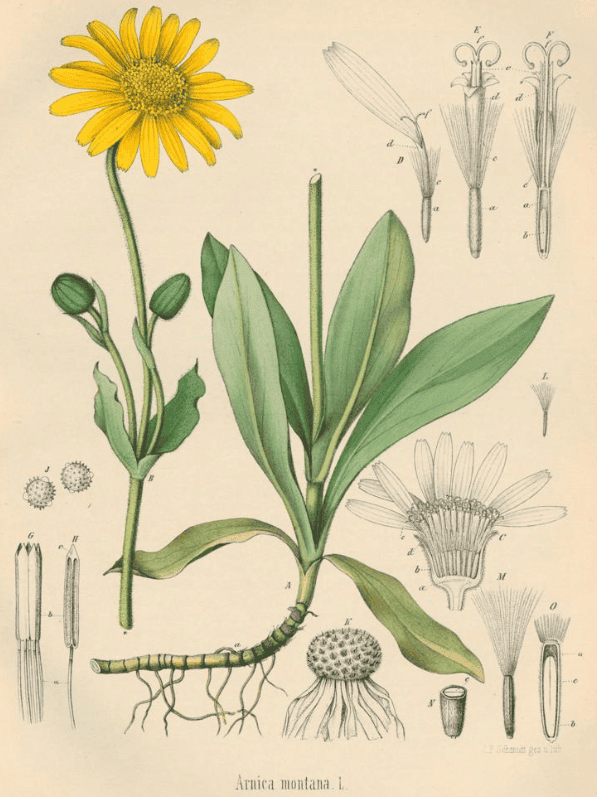ArnicaLeopard’s Bane, Mountain Arnica, Mountain Tobacco |

|
 Losch, F., Krauterbuch, unsere Heilpflanzen in Wort und Bild, Zweite Auflage, 1905
Losch, F., Krauterbuch, unsere Heilpflanzen in Wort und Bild, Zweite Auflage, 1905 Atlas der Officinellen Pflanzen, Berg & Schmidt, Leipzig, 1893
Atlas der Officinellen Pflanzen, Berg & Schmidt, Leipzig, 1893 Kohler’s Medizinal Pflanzen, 1887
Kohler’s Medizinal Pflanzen, 1887Botanical name:
Arnica montana
Parts used:
Root, flower; less commonly the leaf
Temperature & Taste:
Warm, dry. Bitter, pungent. Slightly Toxic
Uses:
1. Moves the Blood, Clears Stasis:
-Chest pain, Palpitations, Coronary Heart disease
-Heart weakness, Congestive Heart failure
-circulatory disorders with cold extremities, cyanosis
-poor cerebral circulation with dullness, depression, neurasthenia
-concussion (a few drops of the tincture on the tongue hourly for several hours)
-internally and topically for Bruising, Blood stagnation, Trauma
-Venous insufficiency
-Amenorrhea
2. Moves the Blood, Resolves Masses:
-Swelling and hardness of the Liver or Spleen
-Tumors and Cancers
3. Resists Poison:
-used in Antidotes
-Fevers
-antipyretic in Typhus and Typhoid Fever
3. Clears Wind-Damp, Settle Spasms
-chronic Rheumatism, chronic Neuralgia
-Paralysis
-internally for Tinnitus (15 drops of tincture in a tablespoon of Arnica infusion, three times daily.
4. Stops Bleeding:
-Excess Menstruation, Postpartum Bleeding
-has been used (cautiously) for Threatened Miscarriage
-Hemoptysis, Epistaxis
5. Externally:
-flowers are strong errhine
-tincture applied to the scalp promotes Hair Growth
-tincture is dropped in for Earache
-tincture has been recommended as an excellent foot bath if a little of the tincture is added to a hot foot bath.
-effective for Sore Muscles, Sprains and Strains
-Trauma with Bruising as long as the skin is not broken
-Hematoma, Dislocations, local Edema associated with Fractures. (Tincture)
-Scalds, Frostbite, Carbuncles, Abscesses, Furunculosis, Trophic Ulcers, Varicose Veins. (Tincture, Poultice)
-as a gargle for Inflammation of the Mouth and Throat
-tincture has been applied to various Insect Bites.
Dose:
Flowers: 5 grains–half dram (300–1800mg)
Root: 2 grains–half dram (130–1800mg)
Tincture of the Flowers (1:5): 5–30 mls. 2–5 drops, every hour for a few hours after Trauma or Concussion
Tincture of the Root (1:20): half–1 fluid dram
Substitute:
1. Calendula can be used for the Flowers
2. Zedoary can be used for the Root
Main Combinations:
1. Bruising:
i. Arnica tincture, Myrrh tincture, equal parts
ii. Arnica flowers, Rue applied topically as a fomentation.
iii. topically, Arnica tincture with Spirits of Camphor diluted
2. Heart weakness with Anxiety or Nervousness:
i. Arnica flower, Borage, Rue, Balm
ii. Arnica flower, Peppermint, Valerian
3. Amaurosis (partial or total blindness), Arnica flower, Valerian, Asafetida (2 drams each), Extract of Pulsatilla (½ oz.); make pills of 2 grains each.
4. Excess Menstruation, Arnica flower, Valerian, Balm, Yarrow, Sage
5. Varicose veins, the flowers are taken with Yarrow and St. Johns wort
6. An oil for Wounds (even when the bone is showing) is made with St. Johns wort, Arnica flower, Calendula and Saffron (Weiss)
Major Formulas:
1. Compound Infusion of Arnica:
Arnica flowers (1 dram), Camomile (half ounce), Peppermint (2 drams), Boiling water (9 oz.); infuse, strain. Dose: 1 oz. (Pharmacopoeia Militaris, 1818)
2. Swiss Purgative:
i. Wormwood, Betony, Bugle, Mint, Vervain, Water Germander, Germander, Hyssop, Ground Ivy, Yarrow, Marjoram, Periwinkle, Rosemary, Sanicle, Sage, Thyme, Wild Thyme, Arnica flowers, Coltsfoot flowers (equal parts)
This is a gentle cleanser which may safely be taken on an extended basis. It clears Heat and Phlegm, regulates the Stomach and Bowels, cleanses the Liver and Spleen etc. It is not debilitating as are stronger purgatives medicines, but rather works by stimulating healthy function. A tablespoonful may be steeped in a cup of boiling water, and honey added to taste.
3. Maria Trebens Heart Formula
Hawthorn, 30 grams
Mistletoe, Yerba Mate, of each 20 grams
Dandelion, Silverweed, Motherwort,
Bean pods, Knotgrass, Hemp Nettle,
Fumitory, Couch grass, Lemon Balm,
Calamus, Rue, Arnica, Yarrow, Burdock,
Horsetail, Irish Moss, Shepherd’s Purse,
Lesser Burnet, Rest Harrow, Kelp,
Frangula bark, of each, 10 grams
These herbs are cut finely and mixed well.
A regulating Heart tonic, suitable for long-term use.
To use, 1 heaped teaspoonful is steeped (per cup of cold water) overnight, which can then be warmed in a water bath. A cup of this tea is taken warm with a teaspoonful of honey, morning and night. (Maria Treben)
Cautions:
Weiss said ‘Arnica is extremely well tolerated when administered internally’.
1. Irritant and toxic in overdose. Avoid overdose, and avoid using full doses for more than 2 weeks.
2. Symptoms of poisoning include Vomiting, Diarrhea, Tachycardia then Bradycardia, then coma.
3. Best not used during pregnancy, although it has been used (in skilled hands) for Threatened Miscarriage.
4. Allergies including dermatitis (with topical use) have been reported.
5. Externally, it is not applied to broken skin.
Antidote:
1. Opium; Morphine
Main Preparations used:
Tincture
1. Arnica Tincture:
Arnica root 80 parts
Arnica flowers 20 parts
Brandy 500 parts
Infuse to form a tincture.
-
Extra Info
- History
|
‘The older botanists as Matthiolus, Gesner, Camerarius, Taberntemontanus, and Clusius were acquainted with Arnica and had some knowledge of its medicinal powers, which appear to have been expressly recommended, towards the end of the 16th century, by Franz Joel, professor of Greisswald, Germany. All parts of the plant were no doubt popular remedies in Germany at an early period, but Arnica was only introduced into regular medicine on the recommendation of Johann Michael Fehr of Schweinfurt and of several other physicians. But for enthusiastic laudation of the new remedy, all these writers fall far short of Collin of Vienna, who imagined that in Arnica he had found a European plant possessing all the virtues of Peruvian Bark. In his hands |
fevers and agues gave way under its use, and more than 1000 patients in the Pazman Hospital were alleged to have been cured of intermittents by an electuary of the flowers, between 1771 and 1774! Such happy results were not obtained by other physicians. Arnica (herba, flos, radix) had a place in the London Pharmaco-poeia of 1788, but it soon fell out of notice, so that Woodville writing in 1790, remarks that he had been unable to procure the plant from any of the London druggists. Of late years it has gained some popular notoriety as an application in the form of tincture, for preventing the blackness of bruises, but in England it is rarely prescribed internally. (Pharmacographia, Fluckiger & Hanbury, 1879) |
